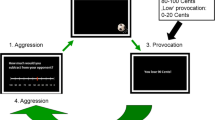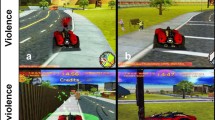Abstract
Dynamic changes in the activities of different areas of the brain cortex were studied in order to determine cortical structures responsible for playing aggressive computer games, with the degree of initial aggression of the adolescent subjects taken into account. Changes in anxiety and aggression produced by aggressive computer games were found to depend on the initial level of aggression of the subjects. In adolescents with a high baseline level of aggression, the amplitude of the N200 component increased in the frontal and decreased in the temporal areas of the cortex, whereas, in adolescents with a low baseline aggression level, N200 decreased in the frontal and increased in the temporal cortical areas.
Similar content being viewed by others
References
Fahrenberg, J., Hampel, R., and Selg, H., Das Freiburger Persönlichkeitsinventar-FPI, Hogrefe, 1989.
Rogge, J.U., Kinder haben Ängste; von starken Gefühlen und schwachen Momenten, Reinbek, Hamburg, 1997.
Butner, K., Zhit’ s agressivnymi det’mi (Dealing with Aggressive Children), Moscow: Pedagogika, 1991.
Zavrazhin, S.A., Aggressive Fantasies in the Childhood and Adolescence, Vopr. Psikhol., 1993, no. 5, p. 43.
Il’in, E.P., Motivatsiya i motivy (Motivation and Motives), Moscow, 2000.
Dengerink, H.A., Anxiety, Aggression, and Physiological Arousal, Exp. Res. Person., 1971, no. 5, p. 223.
Dorsky, F.S. and Taylor, S.P., Physical Aggression as a Function of Manifest Anxiety, Psychon. Sci., 1972, vol. 27, p. 103.
Chadaeva, M.V., Aggression as a Biosocial Problem of the Pubertal Period, in Psikhologiya XXI veka (Pschology of the 21st Century) (Abstracts of Students’ International Scientific and Practical Conference of Higher Education Institutions), St. Petresburg: St. Petersburg Gos. Univ., 2000.
Davidson, R.J., Jackson, D.C., and Kalin, N.H., Emotion, Plasticity, Context and Regulation: Perspectives from Affective Neuroscience, Psychol. Bull., 2000, vol. 126, p. 890.
Davidson, R.J., Pizzagalli, D., Pascual-Marqui, R.D., et al., Anterior Cingulate Activity as a Predictor of the Degree of Treatment Response in Major Depression: Evidence from Brain Electrical Tomography Analysis, Am. J. Psychol., 2001, vol. 158, p. 405.
Frierson, R.L. and Finkenbine, R.D., Psychiatric and Neurological Characteristics of Murder Defendants Referred for Pretrial Evaluation, J. Forens. Sci., 2004, vol. 49, no. 3, p. 604.
Moya-Albiol, L., The Neuronal Foundations of Human Violence [article in Spanish], Rev. Neurol., 2004, vol. 38, no. 11, p. 1067.
Murray, J.P., Children and Television Violence, Kans. J. Law, 1995, vol. 4, no. 3, p. 7.
Antonyan, Yu.M., Features of Sexual Crime, Rossiya Sovr. Mir, 2000, vol. 27, no. 2, p. 170.
Heinrichs, R.W., Frontal Cerebral Lesions and Violent Incidents in Chronic Neuropsychiatric Patients, Biol. Psychiatry, 1989, vol. 25, p. 174.
Silver, J.M. and Yudofsky, S.C., Aggressive Behavior in Patients with Neuropsychiatric Disorders, Psychiatr. Ann., 1987, vol. 17, p. 367.
Murrey, J.P., Successful Faculty Development and Evaluation, Washington: George Washington Univ., 1997.
Khomskaya, E.D. and Batova, N.Ya., Mozg i emotsii (Brain and Emotions), Moscow, 1992.
Fox, N.A., The Development of Emotion Regulation: Biological and Behavioral Considerations, in Monographs of the Society for Research in Child Development, 1994, vol. 59 (2/3, Serial no. 240), p. 152.
Piliponich, A.V., Zakharov, V.V., and Damulin, I.V., Frontal Malfunction in Vascular Dementia, Klin. Gerontol., 2001, vol. 5, no. 6, p. 35.
Lebedeva, I.S., Abramova, L.I., and Bondar’, V.V., Auditory Evoked Potentials in Patients with Schizophrenia and Affective Disorders, Zh. Nevrol. Psikhiatr. im. S.S. Korsakova, 2002, no. 1, p. 56.
Albrecht, B., Banaschewski, T., Brandeis, D., et al., Response Inhibition Deficits in Externalizing Child Psychiatric Disorders: An ERP-Study with the Stop-Task, Behav. Brain Funct., 2005, vol. 1, p. 22.
Author information
Authors and Affiliations
Additional information
Original Russian Text © V.G. Grigoryan, L.S. Stepanyan, A.Yu. Stepanyan, A.R. Agababyan, 2007, published in Fiziologiya Cheloveka, 2007, Vol. 33, No. 1, pp. 41–45.
Rights and permissions
About this article
Cite this article
Grigoryan, V.G., Stepanyan, L.S., Stepanyan, A.Y. et al. Influence of aggressive computer games on the brain cortex activity level in adolescents. Hum Physiol 33, 34–37 (2007). https://doi.org/10.1134/S0362119707010057
Received:
Issue Date:
DOI: https://doi.org/10.1134/S0362119707010057




